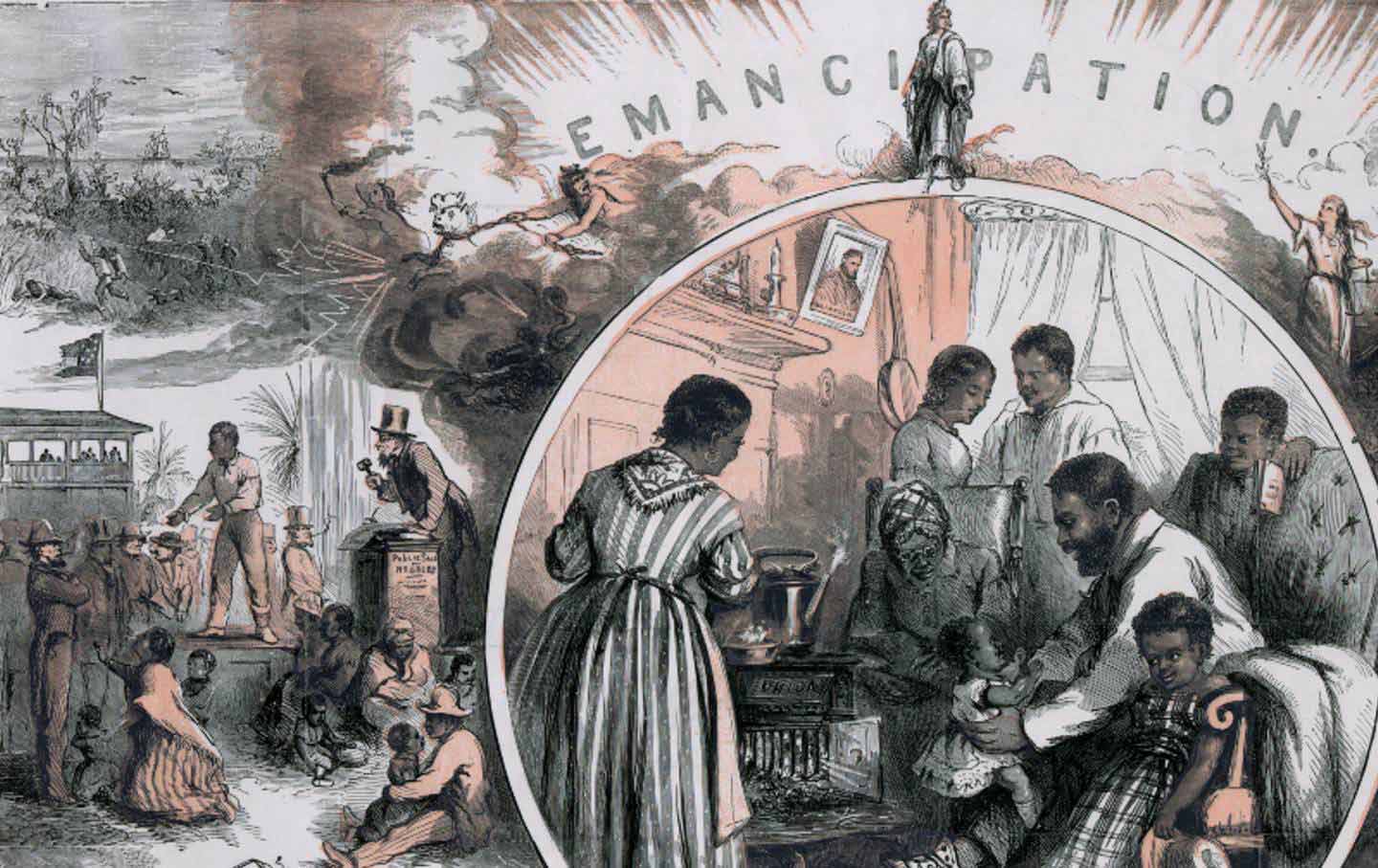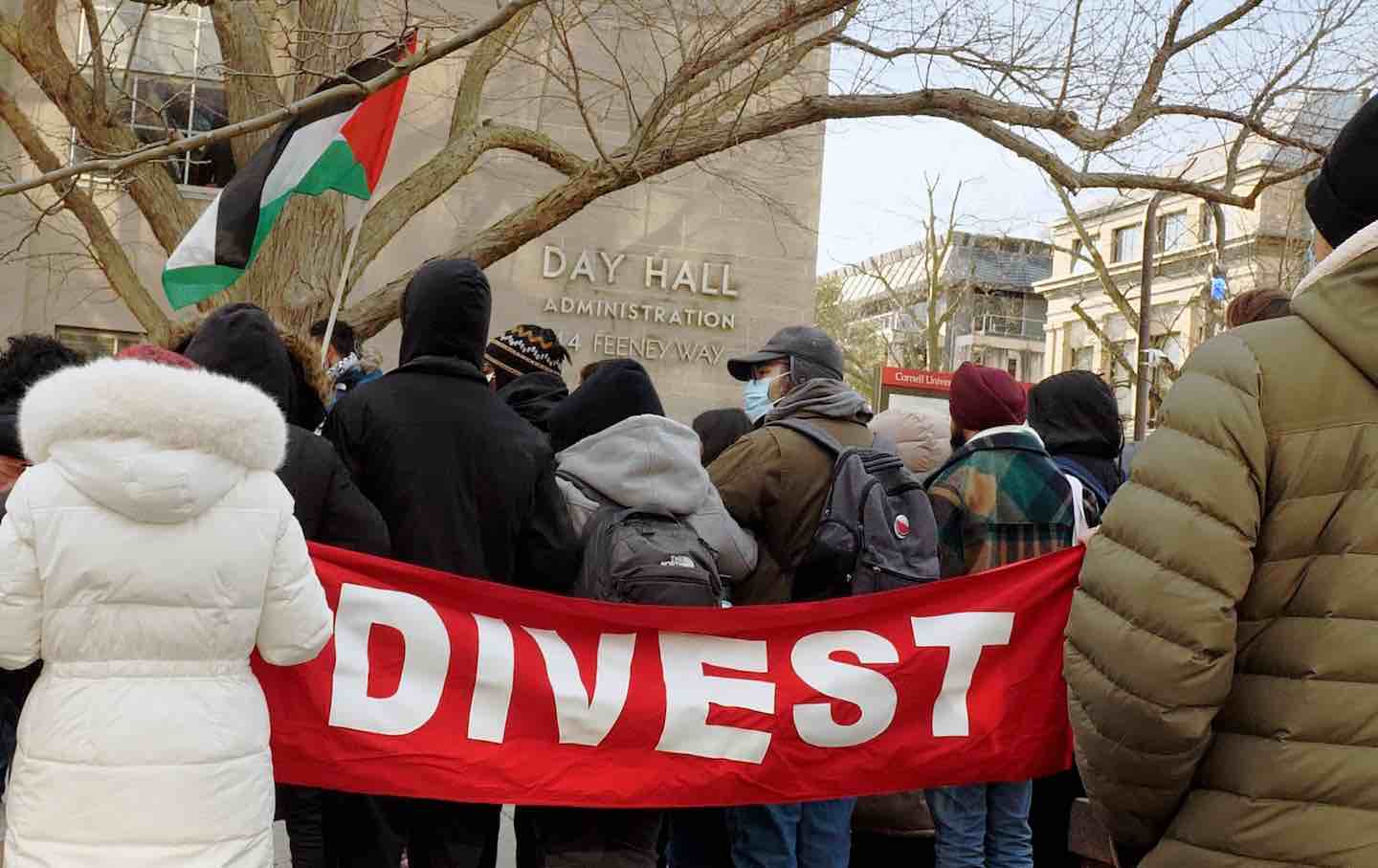The Second Abolition
Robin Blackburn’s sweeping history of slavery and freedom in the 19th century.
Slavery in an Age of Emancipation
Robin Blackburn’s sweeping history of slavery and freedom in the 19th century.

Robin Blackburn is undoubtedly one of the most prolific writers on the transnational histories of slavery and abolition in the Americas today. Along with essays and books on everything from the history of modern finance to the fall of communism, he has written a series of major works on enslavement in the modern age as well as its eradication. In his 1988 The Overthrow of Colonial Slavery, 1776–1848, he examined the abolition of slavery during the Age of Revolutions. In his 1997 The Making of New World Slavery: From the Baroque to the Modern, 1492–1800, he linked the rise of plantation slavery in the Americas to the transformation of commerce and consumption in early modern Europe. And in his 2011 The American Crucible: Slavery, Emancipation and Human Rights, he traced the abolitionist roots of modern human rights discourse. For Blackburn, the histories of enslavement and emancipation are pivotal in understanding our modern world and its economies as well as its ideological preoccupations.
Now, in his latest formidable synthesis, The Reckoning: From the Second Slavery to Abolition, 1776–1888, Blackburn recounts the long undoing of the “second slavery” in the United States, Cuba, and Brazil. Charting this history from the early 19th century to the American Civil War and the eventual abolition of slavery in Cuba and Brazil in the late 19th century, he examines how the last slave societies in the Americas finally got rid of enslavement through an arduous process that involved grassroots abolitionist activism as well as state intervention and warfare. While historians have given us accounts of the second slavery before, Blackburn is one of the first to provide us with a comprehensive narrative of what one may call the “second abolition.”
The idea of a “second slavery” in the 19th century comes from the work of the late historian Dale Tomich. By the early 19th century, slavery appeared to be mostly on its way out. The British Empire and the United States had both abolished the African slave trade in 1808. Meanwhile, the Northern states of the US and many of the new Latin American republics had passed gradual emancipation laws that freed the children of the enslaved. But slavery nonetheless resurged, both in the United States and outside of it, as Tomich demonstrated in his many books on the second slavery: The rise of slave-grown cotton in the American South, sugar in Cuba, and coffee in Brazil marked a new phase of slave labor in the Western Hemisphere, in which new and expansive plantation economies were tied to the rise of early capitalism and the world market.
To tell his version of this story, Blackburn begins his account of slavery in America, Brazil, and Cuba—“the ABC territories,” as he calls them—with the “first slavery” of the colonial era and the age of republican revolutions in the Americas rather than with the rise of the second slavery of the early 19th century. He discusses the rise and fall of colonial slavery in the ABC territories and the abolition of the African slave trade briefly in three introductory chapters. For Blackburn, the passing away of the first slavery, which was legal throughout the Americas, gave way to an expansive and profitable second slavery in the US South, Brazil, and Cuba. What made the slavery of the 19th century so different from its predecessors was that it “was haunted by its betrayal of the ideals of creole republicanism” that had seen slavery eradicated in much of the Americas. But what emerged, Blackburn notes, was something even more potent: “a turbo-charged and financialized version of servitude.”
Here Blackburn’s versatile knowledge of the history of modern finance capitalism clearly shows in his discussion of the internal markets and international credit flows of the new slave economies. According to him, the collapse of colonial mercantilism and the creation of a “white man’s republic” based on Native American dispossession and “a new racial slave regime” laid the foundations of the second slavery in the US South. Similarly, a plantation revolution in Cuba made it the largest supplier of sugar in the world by the 19th century. Even as the Latin American republics gradually did away with slavery after their wars of independence, Cuba and Puerto Rico remained slave colonies governed by a Hispanic elite in the Spanish Empire.
Similarly, the lifespan of the Brazilian Empire, which lasted from 1822 to 1889, defined the second slavery there. Along with Cuba, Brazil emerged as an important hub and destination of choice for the African slave trade, especially after the United States abolished it in 1808. Slavery in Brazil also flourished under the Portuguese emperor as plantation agriculture began to take over more and more land from Indigenous people, though Blackburn contends that the Brazilian plantation system only really took off with the coffee revolution of the mid-19th century.
The story so far has been recounted in the past, but Blackburn’s ability to distill meaning and connect developments across time and space allows him to map the emerging new slave economy as a single integrated whole and to offer a view of how each country’s slave system fit into a larger order of “racial capitalism.” At times, this more global view can obscure some of the details and differences that distinguished the plantation economies in the United States, Brazil, and Cuba. Although Blackburn writes with great acuity about what the fugitive-slave abolitionist J.W.C. Pennington called “the chattel principle” of slavery, which reduced human beings to property, his descriptions of plantation life and work do not engage with Edward Baptist’s notion that the second slavery was also defined by the regimes of torture and extraction found in the “slave labor camps.”
Probably the most generative part of Blackburn’s book, not surprisingly, is his examination of the political economy of the second slavery era. At least in the opinion of this reviewer, his insights on the relationship between slavery and capitalism are worth quoting at length: “The advance of industrial capitalism in the nineteenth century was uneven and incomplete; a species of para-industrial slavery helped to bridge the gaps and facilitate the accumulation process…. Slavery included a pre-capitalist residue, but it was now locked within the orbit of industrial capital.”
While the first slavery era was a product of colonial wars and the struggle for new republics, the second was an offspring of industrial capitalism and the growth of the world market. Going back to Marx himself, who argued for the significance of slavery in contemporary capitalist development, Blackburn follows the economic historian Gavin Wright in contending that the planters were capitalists: They sought to maximize profits and participated in the new credit circuits of financial capitalism, even as these had a regressive effect on local slave economies.
The development lag that the second-slavery economies created was significant. Profitability, Blackburn warns, should not be mistaken for economic development. And yet the stereotypes of backward slave economies, he insists, can also create “a quite misleading impression of the articulation of plantation slavery within industrial capitalism.” Even as the plantation systems in the US South, Cuba, and Brazil may have hindered the growth of local economies, the enslaving planters were in sync with the larger boom-and-bust economy of early capitalism. This was especially true when it came to sugar plantations, which adopted mechanization and factory techniques.
Blackburn situates his economic history of the second slavery against the backdrop of a growing antislavery politics emerging in the rest of the world. After the Napoleonic Wars and the 1815 Congress of Vienna, which established a distinctly conservative peace in continental Europe, European countries joined the British in the attempt to stamp out the African slave trade.
Blackburn, unlike most other historians of antislavery, is careful to differentiate the state from the abolition movement, which sought to end slavery in the British Empire rather than use the moral capital of abolition as an excuse for imperialism, but his claim that “mainstream British and US abolitionism opposed the anti-slave-trade patrols” of the British Navy’s West Africa Squadron perhaps goes too far. Most abolitionists did reject gunboat diplomacy and called for universal emancipation as the only way to end the slave trade, and yet they did not oppose the efforts of the British Navy to stamp out the African slave trade.
Even as most European states reluctantly disavowed the transatlantic slave trade under British pressure, some Southern slaveholders in the US began to dream of a proslavery empire extending from the American South to Cuba to Nicaragua and called for the African slave trade to be reopened in the United States. Their proslavery imperialism was the basis of what the historian Gerald Horne has called “the White Pacific,” a formal American empire, and what Blackburn describes as their racial destiny hubris. It was also the animating spirit, he concludes, behind Western imperialism (I would add the search for markets, raw materials, and cheap exploitable labor), when the European great powers carved up Africa at the Berlin Congress of 1883–84. As Blackburn perceptively shows, the history of imperialism is intertwined with the long afterlives of slavery rather than the rise of abolition.
When Blackburn turns to the United States’ eventual eradication of slavery, he covers well-trodden ground, as he himself admits: “My account of the path to Civil War has furnished what might seem a not unfamiliar sequence of flashpoints and stepping stones on that mine-strewn track.” When he relies on outdated scholarship for his arguments, he sometimes falters. No historian today would call the Confederacy a modern democracy, as B.H. Liddell Hart did in 1964 when he described the Civil War as “the first between modern democracies.” Yet when Blackburn relies on his own scholarship and on more contemporary accounts, the story he tells is compelling, as when he quotes Marx on Lincoln: “President Lincoln never ventures a step forward before the tide of circumstances and the call of general public opinion forbid further delay. But once ‘old Abe’ has convinced himself that such a turning point has been reached, he surprises friend and foe alike by a sudden operation executed as noiselessly as possible.”
Popular
“swipe left below to view more authors”Swipe →Blackburn also correctly foregrounds the abolitionists and radicals in the emancipation process and during Reconstruction, when they attempted to establish an interracial democracy in the South. And he offers a pithy observation on what the overthrow of Reconstruction meant: “The egalitarian vision of radical abolitionism was largely betrayed by the later evolution of robber-baron capitalism, imperialism and racism in the United States.”
The last two chapters of The Reckoning concentrate on Cuba and Brazil. In them, Blackburn seeks to link the history of emancipation in North America with that of Latin America, especially since most US historians tend to ignore the latter. As Blackburn states, it is worth looking at the somewhat “tardy emancipation process” in the Americas as a whole. Slavery in both Cuba and Brazil ended in an even tardier fashion than in the United States: Free-womb laws to emancipate the children of the enslaved were initiated in Cuba and Brazil in 1870 and 1871, respectively, which “condemned slavery to a lingering death,” since these free-womb laws, like the revolutionary era’s gradual emancipation laws, did not free the currently enslaved.
In Cuba, Blackburn tells us, the demands for emancipation became intertwined with the fight for independence from Spain in the 1860s and ’70s, especially given the prominence of Afro-Cuban generals and soldiers who combined anti-colonialism with anti-racism. Many enslaved Cubans also took advantage of the war to simply flee slavery. In Spain itself, “abolitionist ideology had made headway among opponents of arbitrary colonial rule, clericalism and monarchism.” But with the reestablishment of Spanish rule and loyal Cuban hacendados or planters, the momentum for emancipation stalled.
Slavery in Cuba did eventually crumble by the 1870s and ’80s, when the enslaved began to negotiate and buy their freedom on their own initiative. Blackburn shows how the number of enslaved people fell dramatically, from 200,000 in 1878 to 25,000 in 1886, when slavery was finally abolished by Spain in Cuba. As elsewhere, the enslaved were the architects of their own liberation.
The last emancipation in the Americas, in Brazil—where slavery, as Blackburn writes, was “both deeply traditional and bang up to date”—faced vigorous opposition from “coffee barons, sugar magnates and other rural notables.” The abolition of the African slave trade in 1850 and the Triple Alliance War against Paraguay (from 1864 to 1870) paved the way for emancipation. Nearly 16,000 enslaved people were freed by military manumission. The rise of Afro-Brazilian abolitionists like Luis Gama, José Carlos do Patrocinio, Joaquim Nabuco, and Quinto de Lacerda helped what Blackburn aptly calls Brazil’s crabwise road to emancipation. The Rio Branco or free-womb law of 1871 was solicitous of slaveholders’ property rights, forcing the enslaved to cushion the blow of emancipation with onerous labor obligations to planters.
Blackburn’s description of the Brazilian abolition movement as consisting mainly of urban professionals and labor would have benefited from consulting Isadora Moura Mota’s work on the enslaved, who rebelled against slavery and hailed Lincoln as a liberator. He does acknowledge, though, that “the slaves themselves played a decisive part in disrupting the running of the plantations in 1887–88.” And while he notes the importance of Afro-Brazilians, Blackburn still labels Brazilian abolitionism as bourgeois or petty bourgeois if not “strictly capitalist.” But he correctly portrays Brazilian emancipation, the Golden Law of 1888, as a product of the abolitionist offensive of the 1880s rather than as a capitalist trick, as is fashionable among some historians. A year later, the Brazilian monarchy was overthrown by a military coup.
Despite the unfinished nature of emancipation in the US South with the end of Reconstruction, in a post-emancipation Cuba held hostage to the interests of US capitalists and imperialists, and in a post-emancipation Brazil where planters retained the upper hand politically and economically, Blackburn acknowledges the revolutionary and world-historical significance of the second abolition. “Abolition,” he explains, “came as the prodigious result of a conflict between the semi-colonial, semi-industrial state and the class struggle between slave-holders and non-slave-holders” in the 19th century. But emancipation remained incomplete nonetheless, generating a reactionary backlash among elites in all three of his “ABC territories,” which would soon experiment with forms of unfree labor, indentured servitude, contract labor, peonage, and convict lease labor. This did not, Blackburn cautions, create a “third slavery” but rather a rapacious capitalism, building on the toxic legacies of slavery and colonialism that still haunts the Americas. The demand for a moral reckoning unleashed by abolition continues to this day.
We cannot back down
We now confront a second Trump presidency.
There’s not a moment to lose. We must harness our fears, our grief, and yes, our anger, to resist the dangerous policies Donald Trump will unleash on our country. We rededicate ourselves to our role as journalists and writers of principle and conscience.
Today, we also steel ourselves for the fight ahead. It will demand a fearless spirit, an informed mind, wise analysis, and humane resistance. We face the enactment of Project 2025, a far-right supreme court, political authoritarianism, increasing inequality and record homelessness, a looming climate crisis, and conflicts abroad. The Nation will expose and propose, nurture investigative reporting, and stand together as a community to keep hope and possibility alive. The Nation’s work will continue—as it has in good and not-so-good times—to develop alternative ideas and visions, to deepen our mission of truth-telling and deep reporting, and to further solidarity in a nation divided.
Armed with a remarkable 160 years of bold, independent journalism, our mandate today remains the same as when abolitionists first founded The Nation—to uphold the principles of democracy and freedom, serve as a beacon through the darkest days of resistance, and to envision and struggle for a brighter future.
The day is dark, the forces arrayed are tenacious, but as the late Nation editorial board member Toni Morrison wrote “No! This is precisely the time when artists go to work. There is no time for despair, no place for self-pity, no need for silence, no room for fear. We speak, we write, we do language. That is how civilizations heal.”
I urge you to stand with The Nation and donate today.
Onwards,
Katrina vanden Heuvel
Editorial Director and Publisher, The Nation
More from The Nation

How Wisconsin Lost Control of the Strange Disease Killing Its Deer How Wisconsin Lost Control of the Strange Disease Killing Its Deer
Despite early containment efforts, chronic wasting disease has been allowed to run rampant in the state. That’s bad news for all of us.

The Prison Rodeo at the Heart of Legal Enslavement The Prison Rodeo at the Heart of Legal Enslavement
Angola prison workers make between 2 and 40 cents an hour. They also have a controversial outlet for recreation and to vend their wares at market rate: a rodeo.

How Cornell University Is Quietly Quelling Gaza Dissent on Campus How Cornell University Is Quietly Quelling Gaza Dissent on Campus
The university has emboldened its Office of Student Conduct and Community Standards to ban pro-Palestine protesters from campus “to protect the university community.”

Holding On to Indigenous Heritage in Georgia Holding On to Indigenous Heritage in Georgia
Although Georgia is often left out of the Native American narrative, a small but mighty community in the state is keeping a strong grip on its culture and history.

Everyone Needs to Disavow Neom Everyone Needs to Disavow Neom
Now that they know about the staggering number of deaths the Saudi megaproject has caused, architects have absolutely no more excuses.

Israel Is Still Targeting Palestinian Journalists. Silence Is Not an Option. Israel Is Still Targeting Palestinian Journalists. Silence Is Not an Option.
Journalists around the world have an urgent duty to stand with their peers in Gaza. Instead, too many are saying nothing.


